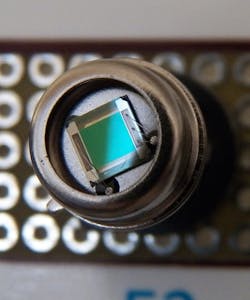MEMS emitters from Cal Sensors deliver pulsed IR light
A family of MEMS emitters is designed with patented, thin-membrane, thermo-resistive material. The nanostructure carbon membranes operate over the 1 to 20 µm IR spectrum. Delivering quasi-blackbody pulsed IR light, they offer higher modulation frequencies up to 100 Hz and temperatures (750°C) to maximize s/n performance for medical, environmental, and process control applications.
Cal Sensors
Santa Rosa, CA
www.calsensors.com
More Products
-----
PRESS RELEASE
CAL SENSORS TO LAUNCH NEW MEMS EMITTER AT PITTCON 2013
SANTA ROSA, CA - Cal Sensors (www.calsensors.com) will introduce a new MEMs emitter as part of its new product line of infrared (IR) sources at PITTCON, booth 4103, held at the Pennsylvania Convention Center in Philadelphia from March 17-21.
Applying MEMs technology, these emitters are designed with patented, thin-membrane, thermo-resistive material. The nanostructure carbon membranes operate over the 1 to 20 micron infrared spectrum. Delivering quasi-black body pulsed IR light, these sources offer higher modulation frequencies (up to 100 Hz) and temperatures (750°C) to maximize signal to noise performance for a broad range of applications including medical, environmental and process control. The emitters require minimal input power, making them particularly well suited for portable applications.
Cal Sensors Contact Information
For additional information or engineering assistance:
In North America, contact Cal Sensor's Sales Department, 5460 Skylane Blvd., Santa Rosa, CA 95403, USA. Phone: +1 (707) 303-3837. FAX: +1 (707) 545-5113. E-mail: [email protected] Web: www.calsensors.com.
Cal Sensors also works with distributors in Austria, Belgium, China, Denmark, Finland, France, Germany, Italy, Japan, Korea, the Netherlands, Norway, Sweden, and the United Kingdom. For contact information, please visit http://www.calsensors.com/distributors.htm.
About Cal Sensors
Cal Sensors, an ITW company, has been a leading manufacturer of standard and customized photoconductive (PbS and PbSe) infrared detectors, arrays, and broadband emitters for over 20 years.
Cal Sensors detectors provide superior sensitivity over the 1-5.5 micron wavelengths. Detector configurations include single element, multi-channel, and arrays. Detector technologies include features such as optional spectral filters, optical condensers, thermoelectric coolers, temperature sensors and integrated drive electronics.
Cal Sensors emitters support steady-state or high-pulse rates over the visible to mid-infrared spectrums. Low cost, with high emissivity, reliability and lifetime, Cal Sensors emitters are designed to optimize performance in infrared detection systems.
Manufactured and packaged in Santa Rosa, California and distributed worldwide, Cal Sensors products are offered in standard or custom packages. Common applications include: imaging, spectroscopy, medical, automotive emissions, gas and moisture analysis, temperature measurement, flame detection and combustion control.
For additional information, please visit www.calsensors.com.
-----
Follow us on Twitter
Subscribe now to Laser Focus World magazine; it's free!
